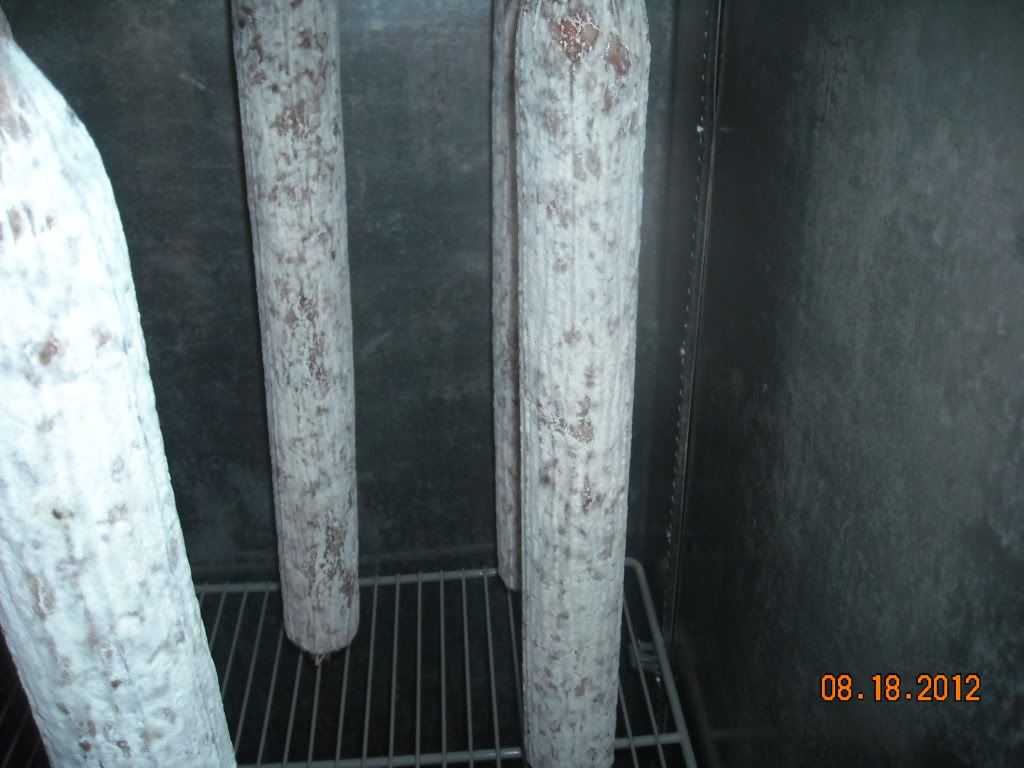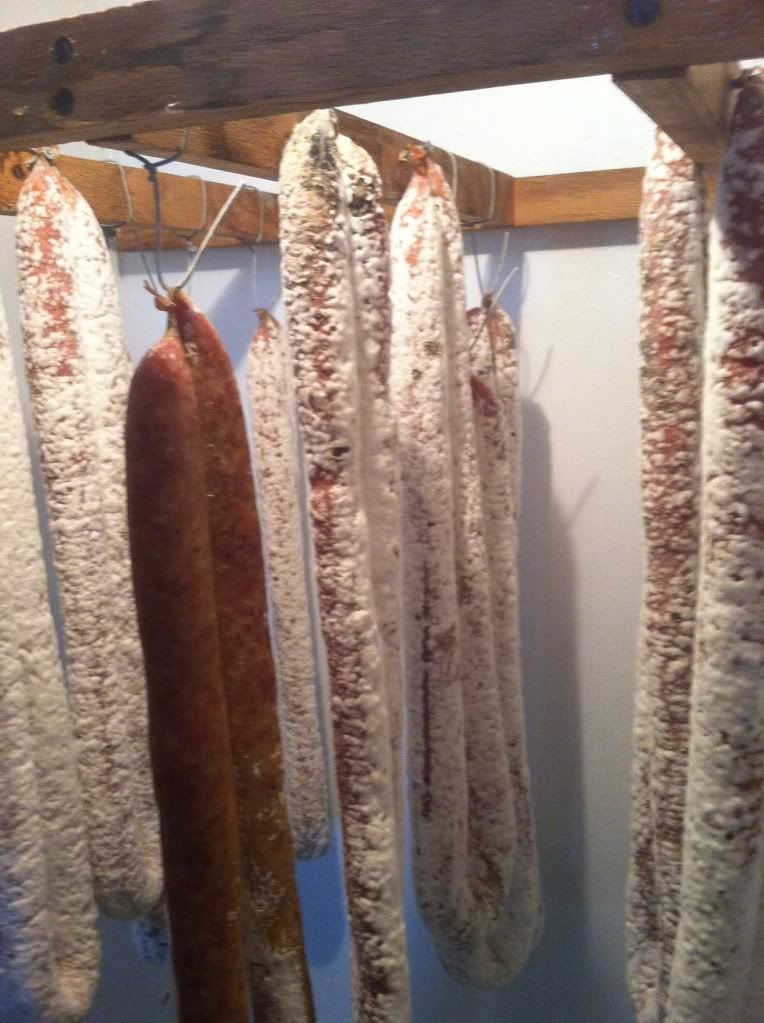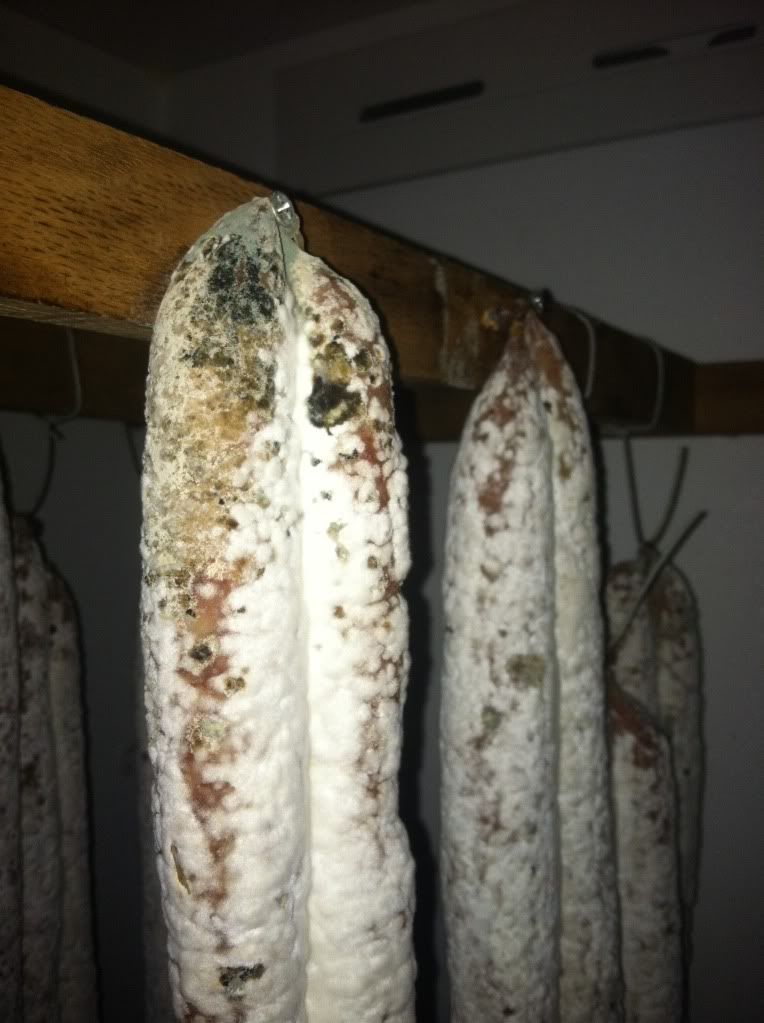Hi Bkamp,
Scientists believe that there may be 300,000 species of fungi. Most are filamentous and most can be transported by air, water, or insects. Of this number, the most common molds affecting meat and poultry are (in alphabetical order),
Alternaria, Aspergillus, Botrytis, Cladosporium, Fusarium, Geotrichum, Monilia, Manoscus, Mortierella, Mucor, Neurospora, Oidium, Oosproa, Penicillium, Rhizopus and
Thamnidium. With the exception of
Penicillium, these are the ones that most often drive sausage makers
kookoolooey (like El Ducko) and often display colors of green, purple, gray, yellow, and others. Some of these species produce poisonous
microtoxins and scientists now estimate that 25% of the world's food crops are affected by them. This is particularly concerning because many of these mycotoxins are also
aflatoxins - species that are also
carcinogenic! The prevention of aflatoxin is one of the most challenging toxicology issues of our day. The federal
Food And Drug Administration and the
United States Department Of Agriculture specifically monitor peanuts and field corn for aflatoxin and have the power to remove any food or feed with unacceptable levels.
On the other hand... there is some good news. One particular species (
Penicillium) is beneficial to us meat-heads! Penicillium is a genus of
ascomyetous fungi. Yup, it is members of this genus that produce
penicillin - a molecule that is used as an antibiotic which kills or stops the growth of certain kinds of bacteria inside our bodies. According to our latest medical publications, the penicillium genus contains
over 300 species. Of these 300 species, only
penicillium nagliovense or
penicillium chrysogenum are recommended for home sausage making. These are the
only two species having the ideal properties we are looking for in home-produced, dry-cured meat - although I`ve known a few people in Europe to use the cheesemaker`s favorites -
penicillium roqueforti and
penicillium camemberti, on meat.

Oh boy! With
penicillium nagliovense and
penicillium chrysogenum at our disposal and readily found on the market (Bactoferm™ is found in most sausage supplier`s catalogs) relatively cheaply, I do not understand why someone would want to cut corners financially by growing their own cultures by using the penicillium
roqueforti and
camemberti cultures (developed especially for cheese) from leftover cheese products.
SOOOoooo..... What does all this have to do with your problem? The thing you need to do is (a.) remove the toxic micro-organisms, and... (b.) replace them with safe, beneficial, white, powdery, flaky, penicillium
nagliovense or penicillium
chrysogenum. How does one go about this? First take a rag slightly dampened with vinegar. Sprinkle on a little salt and rub and remove the colored, toxic mold when it first shows up. It will quickly grow back unless you actually "crowd it out" with beneficial mold. Mix up a little Bactoferm™ "Mold 600"
(previously called M-EK-4). Spray a little on the cleaned sausages and you`ll have a growth of white fluff you won`t believe in a week. The best procedure is to do this immediately after casing the sausage initially. Lots of folks like to "dip" their sausages rather than spray them.
Be aware that if you wait too long to clean off the colored mold, the "roots" may have penetrated the meat. Beneath a microscope, the one-celled mold looks incredible - composed of tiny, skinny, little mushroom-shaped microorganisms. Roots go into the meat, a "stalk" rises above the meat, and spores form at the ends of these stalks. The spores release the toxins and give the mold its color. Don`t smell or "sniff" the stuff! The airborne toxin can cause severe resperitory problems. Moreover, pathogenic bacteria may also accompany the mold. Toss any product that has a heavy growth of "colored" mold. White, powdery,
nagliovense is the only mold you want on the outside of a salami! So, purchase a packet of "Mold-600". The culture has a positive effect on the drying process by preventing the emergence of dry rim. Furthermore, the mold degrades lactic acid during maturation resulting in a pH increase and a less sour flavor.
Store it in your freezer as without refrigeration, it has a shelf life of only 14 days. When frozen, it remains effective for 6 months. Add 3 grams of the M-600 to a cup of 68°;F. lukewarm (not hot) distilled, chlorine-free water, and allow it to develop 12 hours. After the 12 hours, add 1 liter of distilled, chlorine-free water. Dip sausages in the solution or spray it on with a misting sprayer.
Oh, by the way, (just to explain the "lingo" a little)... biologists use "spp." as a short way of saying that something applies to many species within a genus, but do not wish to say that it applies to all species within that genus. Note that spp. = species (plural) and sp.= specie (singular). If scientists mean that something applies to all species within a genus, they use the genus name without the specific epithet.
Welcome to the forum Bkamp. I hope this has helped. Let us know how you get on. Maybe a few photos if you can.
Best Wishes,
Chuckwagon


